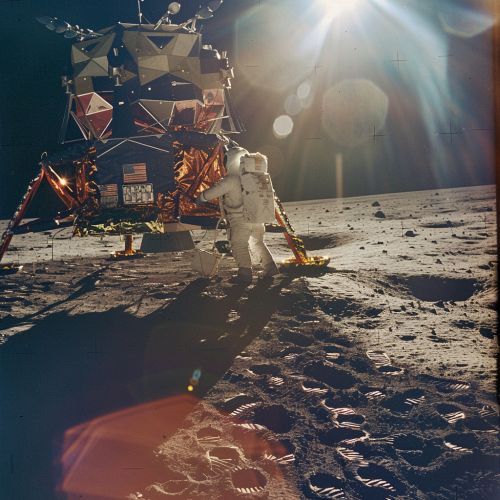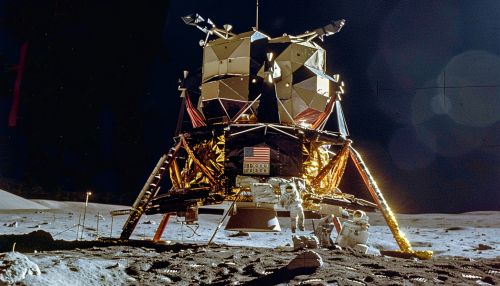Apollo (spacecraft)
Introduction
The Apollo spacecraft was a series of human spaceflight vehicles developed by NASA for the Apollo program, which aimed to land humans on the Moon and bring them safely back to Earth. The program was initiated in response to President John F. Kennedy's 1961 goal of "landing a man on the Moon and returning him safely to the Earth" before the decade's end. The Apollo spacecraft consisted of three main components: the Command Module (CM), the Service Module (SM), and the Lunar Module (LM).
Development and Design
Command Module (CM)
The Command Module was the control center and living quarters for the astronauts. It was a conical capsule designed to re-enter Earth's atmosphere and splash down in the ocean. The CM was equipped with advanced avionics, life support systems, and heat shields to withstand the intense heat of re-entry. The primary contractor for the CM was North American Aviation.
The CM housed the crew during launch, lunar orbit, and re-entry. It featured a pressurized cabin, couches for the astronauts, and a docking mechanism to connect with the Lunar Module. The heat shield was made of an ablative material that charred and burned away, dissipating the heat generated during re-entry.
Service Module (SM)
The Service Module was an unpressurized cylindrical structure attached to the rear of the Command Module. It contained the main propulsion system, electrical power systems, and storage for consumables such as oxygen and water. The SM was jettisoned just before re-entry and burned up in the Earth's atmosphere.
The SM's main engine, the Service Propulsion System (SPS), was used for major maneuvers such as entering and leaving lunar orbit. The SM also housed fuel cells that generated electricity by combining hydrogen and oxygen, producing water as a byproduct. This water was used for drinking and cooling the spacecraft's systems.
Lunar Module (LM)
The Lunar Module was a two-stage spacecraft designed for lunar landing and ascent. It consisted of a descent stage and an ascent stage. The descent stage contained the landing gear, descent engine, and storage for scientific equipment. The ascent stage housed the crew cabin, ascent engine, and docking mechanism.
The LM was built by Grumman Aircraft Engineering Corporation and was designed to operate exclusively in the vacuum of space. It was capable of carrying two astronauts from lunar orbit to the Moon's surface and back. The descent stage remained on the Moon, while the ascent stage returned to the Command Module in lunar orbit.
Missions
Apollo 1
Apollo 1 was the first crewed mission of the Apollo program, intended to test the Command and Service Modules in low Earth orbit. Tragically, a cabin fire during a pre-launch test resulted in the deaths of astronauts Gus Grissom, Ed White, and Roger B. Chaffee. The accident led to significant design changes and safety improvements in the Apollo spacecraft.
Apollo 7
Apollo 7 was the first successful crewed mission, testing the Command and Service Modules in Earth orbit. The mission demonstrated the spacecraft's performance and the crew's ability to conduct long-duration spaceflight. It paved the way for subsequent lunar missions.
Apollo 8
Apollo 8 was the first mission to orbit the Moon. Astronauts Frank Borman, James Lovell, and William Anders conducted a series of orbits around the Moon, capturing the iconic "Earthrise" photograph. The mission provided valuable data on lunar navigation and spacecraft performance.
Apollo 11
Apollo 11 was the first mission to land humans on the Moon. On July 20, 1969, astronauts Neil Armstrong and Buzz Aldrin descended to the lunar surface in the Lunar Module "Eagle," while Michael Collins orbited in the Command Module "Columbia." Armstrong's famous words, "That's one small step for [a] man, one giant leap for mankind," marked a historic achievement in human space exploration.


Subsequent Missions
Apollo 12 through Apollo 17 continued lunar exploration, each mission contributing to scientific knowledge and technological advancements. Apollo 13, famously known for its in-flight emergency, demonstrated the resilience and ingenuity of NASA's mission control and the spacecraft's design.
Technological Innovations
The Apollo spacecraft featured an advanced guidance and navigation system, including the Apollo Guidance Computer (AGC) and the Inertial Measurement Unit (IMU). The AGC, developed by the MIT Instrumentation Laboratory, was one of the first digital computers used in spaceflight. It provided real-time calculations for navigation and control.
The IMU, a critical component of the guidance system, used gyroscopes and accelerometers to measure the spacecraft's orientation and velocity. The data from the IMU was processed by the AGC to maintain accurate navigation throughout the mission.
Life Support Systems
The life support systems in the Apollo spacecraft were designed to sustain the crew in the harsh environment of space. These systems included the Environmental Control System (ECS), which regulated cabin temperature, humidity, and pressure. The ECS also removed carbon dioxide and provided a continuous supply of oxygen.
The spacecraft's water management system recycled water from the fuel cells and stored it for drinking and cooling purposes. The waste management system handled solid and liquid waste, ensuring a hygienic environment for the crew.
Communications
The Apollo spacecraft utilized a sophisticated communications system to maintain contact with mission control and relay data. The system included S-band transponders, VHF radios, and high-gain antennas. The S-band transponders provided voice, telemetry, and television signals, while the VHF radios were used for short-range communications during lunar surface operations.
The high-gain antennas allowed for directional communication with Earth, ensuring a reliable link even at great distances. The spacecraft's telemetry system transmitted vital data on the spacecraft's status and the crew's health to mission control.
Legacy and Impact
The Apollo spacecraft and the missions it supported had a profound impact on space exploration and technology. The program demonstrated the feasibility of human spaceflight beyond low Earth orbit and laid the groundwork for future exploration of the Moon, Mars, and beyond.
The technological innovations developed for the Apollo program, such as the AGC, life support systems, and propulsion technologies, have influenced subsequent spacecraft designs. The program also inspired generations of scientists, engineers, and explorers, fostering a culture of innovation and discovery.
